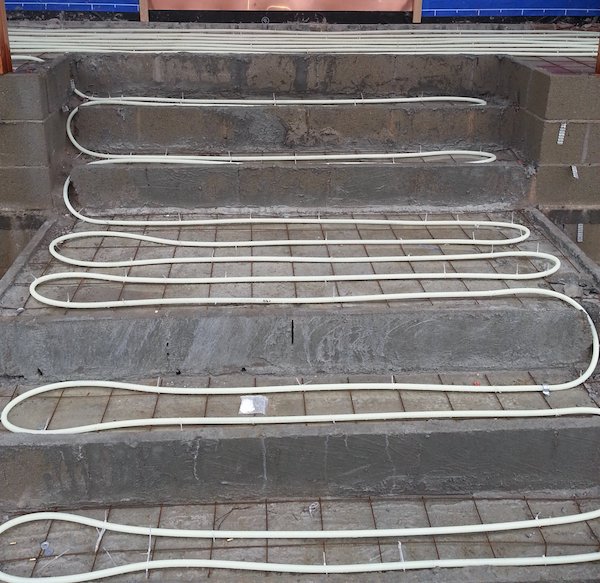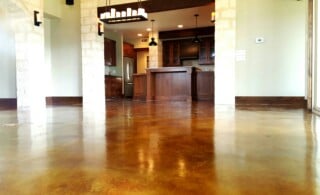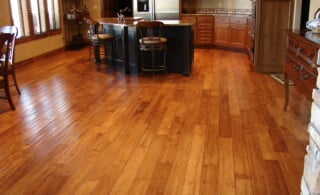
Radiant floor heat is starting to get noticed as a mainstream heating option for homes across the country. There are a number of reasons for this, though primarily it has to do with the quality of the heat it provides. Compared to just about every other heating option on the market, including gas furnaces, boilers, electric baseboard heat, and wood fired stoves, a radiant floor heat system provides the most consistent and comfortable home heating solution, period.
How a Radiant Floor Heat System Works
In case you’re still in the dark about radiant floor heating, the system heats a living space from the ground up. This can be done with either electric or hydronic heating systems that are incorporated into a concrete slab, or installed “dry” beneath your flooring. Here’s a quick description of different radiant floor heat system types to help give you a better understanding of how each one works.
- Electric Radiant Heating Systems usually consist of electrical heating strips or mats that are laid in patterns across a floor, then usually embedded in a thin layer of concrete. The strips or mats heat the concrete, which then radiates heat up into the living area above. Because it’s much cheaper and easier to install, electric radiant heat is especially well-suited if you’re installing radiant heat in small rooms such as a bathroom or bedroom, and for remodels in previously constructed homes.
- Hydronic Radiant Heating Systems are more efficient than electrical ones, but also a much larger project to install. In hydronic radiant heating systems, hot water is pumped through a series of pipes that are laid underneath the floor. Like electric radiant heat, hydronic systems are most often incorporated into a concrete slab which radiates the heat up into the room above. Unlike electric systems, however, it doesn’t matter which type of concrete you use or how thick the slab is. Might not sound like a big deal, but when it comes to radiant floor heat, thicker concrete means more efficient heating. A thicker slab absorbs more heat, puts off more heat, and is less affected by rapid changes in air temperature (such as opening a door to outside).
- The Difference Between a Dry vs. “Wet” Radiant Floor Heat System is the last important factor that every homeowner interested in radiant heat needs to know about. “Wet” systems are the kind mentioned above: a radiant heating system installed in a slab of concrete. This is ideal from an efficiency standpoint, and is the only way to go if you’re planning a heating system for a new home. If you’re working with a pre-existing structure, however, pouring new slabs of concrete might not be a viable option. That’s where dry systems come in. Dry systems, both electric and hydronic, can be installed anywhere, under any flooring surface, without having to encase the heating tubes or coils in a concrete slab. This makes them a great alternative for homeowners who want the benefits of radiant heat without the hassles that are part and parcel to working with concrete.
Ready to start your radiant floor?
Find ProsThe Benefits of Radiant Floor System Heat
The benefits of radiant floor heat are many when compared to other options. From an energy efficiency standpoint, they have an edge on more traditional forms of heating for several reasons. For starters, radiant heating doesn’t create breezes or drafts like forced air heating, which allows you to set the thermostat a few degrees cooler even though the room feels just as warm. And if you live in climate where freezing isn’t a concern, you can install solar radiant heating systems that eliminate the need for any kind of fuel based heating systems or a circulating pump, providing what amounts to free heating once the system is installed. Perhaps the best reason to install radiant heat, however, is comfort. Radiant heat systems don’t spread dust or allergens, they don’t dry out the air, they lose much less heat to outside factors such as drafts or open doors, and they provide a more comfortable, consistent heating experience across the board.
Whether you’re planning a new home build or just want to enjoy the innovative heating experience of radiant floor heat, talking to a contractor or supplier that specializes in radiant heating systems is the best way to get your new radiant heating installation underway.
 Warmer Flooring
Warmer Flooring  Concrete Flooring – Solid as a Rock
Concrete Flooring – Solid as a Rock  Cypress and Hickory Wood Flooring
Cypress and Hickory Wood Flooring  How to Hide Pesky Carpet Seams
How to Hide Pesky Carpet Seams  Flooring Ideas for Your Home Gym
Flooring Ideas for Your Home Gym 

Will engineered maple flooring work well with radiant heat floors? What about linoleum?
I was wondering about installing radiant heat under luxury vinyl planks. Is it feasible and/or advisable?